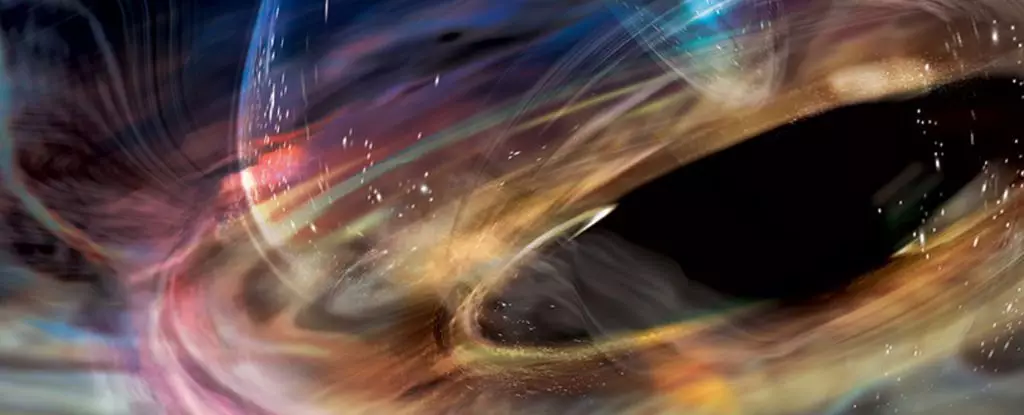Astronomy continuously captivates the human imagination as we strive to decode the complexities of the cosmos. One of the most perplexing phenomena in our universe is the existence and behavior of black holes, particularly the supermassive ones lurking at the centers of galaxies. A fascinating case study is located in the galaxy 1ES 1927+654, approximately 275 million light-years away from Earth. This supermassive black hole has long puzzled scientists, and recent observations reveal intriguing interactions between it and an orbiting white dwarf star, opening new avenues for understanding black holes and their mysterious habits.
Black holes themselves emit no light, enveloping themselves in a cloak of invisibility. Yet, the material swirling around them—often referred to as an accretion disk—is crucial for shedding light on their nature. This heated material, agitated by gravity and friction, radiates energy that can be observed in multiple wavelengths. Scientists typically observe these phenomena to understand the dynamics at play in black hole environments. In the case of 1ES 1927+654, something unusual was detected in 2018 when the black hole’s brightness fluctuated dramatically, increasing nearly twentyfold after a perceived quiescent period. This strange behavior went unexplained for some time, leading scientists to explore various hypotheses, including the radical idea of black hole polar reversals.
Further investigation using data from the European Space Agency’s XMM-Newton space telescope revealed ongoing variability in X-ray emissions from 1ES 1927+654. Astonishingly, the duration between brightness fluctuations compressed from approximately eighteen minutes to fewer than seven during two years. This extraordinary level of variability is termed quasi-periodic oscillations, which are not widely understood but are significant for theorizing about the forces in play. Such rapid oscillations suggest the presence of dynamic structures in close proximity to the black hole’s event horizon—the point beyond which nothing escapes.
Hypotheses and Interpretations: The Role of the White Dwarf
To make sense of this bizarre behavior, astronomers turned to the data, analyzing light wavelengths and oscillation patterns. The prevalent hypothesis emerging from this research posits that a dense object—a white dwarf star—is caught in a precarious orbit around the supermassive black hole. As it spirals inward, it shortens the cycle of brightness fluctuations. Essentially, there exists a cosmic ballet where the white dwarf’s close orbit—approximately 4.2 times the radius of the Sun—allows it to navigate a lethal dance on the edge of destruction.
The white dwarf likely consists of the remnants of a low-mass star that has already shed its outer layers, making it exceptionally dense. This high density may be key to its survival; rather than being fully consumed by the black hole’s gravitational pull, it appears to be shedding material due to tidal forces while maintaining enough momentum to escape annihilation. The ongoing dynamic could lead to observable variations in the star’s behavior, as scientists keenly watch for any slowing of the oscillation periods as the white dwarf recedes to a more stable distance from the black hole.
The intricate interactions between 1ES 1927+654 and its near-residential white dwarf offer valuable insights into black hole dynamics and their effects on surrounding celestial bodies. Such phenomena teach us more about the very nature of gravity and the extreme environmental conditions near black holes. As observed by physicists, this scenario exemplifies how one should always be ready for surprises in astrophysical explorations. The team led by MIT’s physicist, Megan Masterson, certainly anticipates more revelations as they continue to monitor the black hole’s behaviors.
The research presented at the 245th American Astronomical Society meeting invites the scientific community to remain vigilant and curious about evolving narratives in the cosmos. Whether the white dwarf will permanently stabilize or eventually succumb to the overwhelming grasp of the black hole remains to be seen. However, one truth prevails: the cosmos is full of mysteries, and each revelation invites a deeper inquiry into the universal laws that govern existence.
The enigma of 1ES 1927+654 exemplifies the challenges that astrophysicists face as they decode the universe’s intricate workings. With every peak and trough in the light emitted from this supermassive black hole, we are reminded of the delicate balance between destruction and survival found in the cosmos. The iconic dance of the black hole and its white dwarf companion offers a narrative of perseverance amidst chaos, highlighting the undeniable interplay of forces at work in the universe. As we continue to probe deeper into the mysteries that lie beyond our galaxy, the lessons learned here may one day illuminate our understanding of not only black holes but the very fabric of space-time itself.

